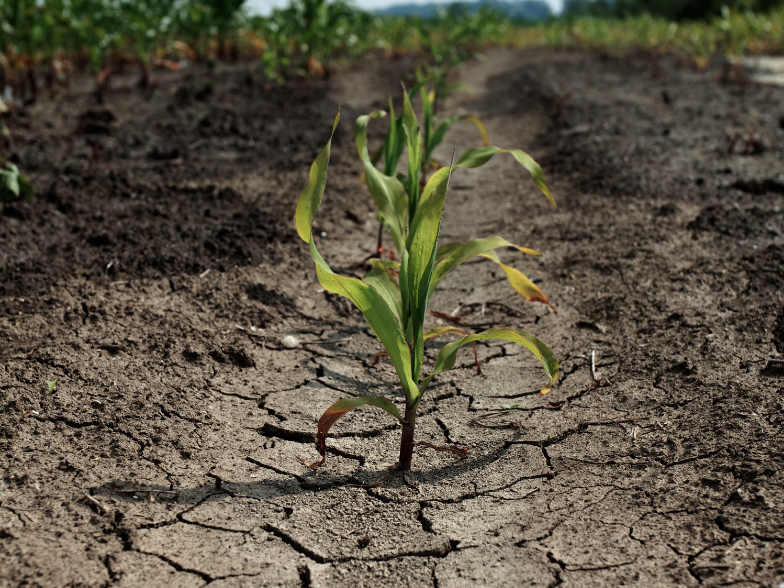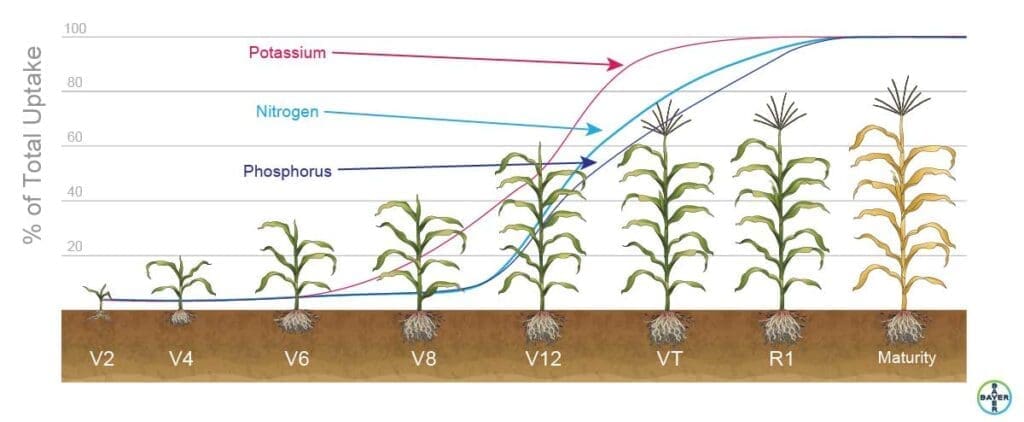
Effects Of Drought On Fertility Availability
Nitrogen Uptake by Corn
Nitrogen is the most important nutrient/largest required nutrient in corn production. Corn takes up N from the soil throughout its active growth. The majority of N is taken up during vegetative growth with about two-thirds of the total N uptake completed by flowering or the R1 growth stage of corn. The highest rate of N uptake occurs during rapid vegetative growth when corn is in the V10 through V14 growth stages. Nitrogen uptake prior to corn flowering is critical to support ear shoot development, kernel number, and potential kernel size. During reproductive growth or post-flowering, corn takes up the remaining of its total N and uses it for grain development.
Drought effects by stage of development
Drought is one of the most common environmental stresses on plants and can negatively impact their growth, development, and reproduction. The amount of corn yield loss that occurs during dry weather depends on what stage the corn is in and how severe the dry conditions become. Drought conditions early in the season from emergence to the V8 corn growth stage can impact early root development and reduce plant and leaf size affecting photosynthesis. Drought occurring during the V8 to V16 growth stages can reduce corn ear size and potential yield. Silking is the most sensitive stage for drought stress to occur, resulting in severe yield reductions due to incomplete pollination and the loss of kernel number. Drought during the reproductive growth of corn affects kernel weight with dry conditions immediately following silking having the largest impact. Drought later in reproductive growth is less damaging but can hasten corn maturity
Drought and Nitrogen Uptake by Corn
If you are tissue sampling your corn for nutritional levels, drought can/will decrease N uptake from soil and reduce the concentration of N in plant tissue—even though you have likely applied “enough.” Nitrogen uptake in dry soil is reduced primarily by the inhibition of root growth along with a decrease in N transport in the soil to the root surfaces. Severe drought can induce root shrinkage and loss of soil-root contact. Here is some good news–Nitrogen uptake ability by corn recovers quickly after rewetting the soil regardless of the length of drought conditions. The recovery of N uptake ability occurs through established older roots as well as the production of new roots. Mild drought stress can initially increase root growth, but severe and long-lasting drought can decrease root growth. With moderate drought stress during corn vegetative growth, rooting depth can increase, allowing more efficient uptake of water and nutrients from deeper within the soil profile. The uptake of N under dry conditions is also increased when soil N fertility is high. Nitrogen deficiency symptoms generally do not appear on corn under drought conditions with high N soil levels. The response of corn to soil water availability is strongly dependent on N levels in the soil. Nitrogen-deficient corn is more sensitive to water deficits than N-sufficient corn. Both water and N stress can lengthen the time from emergence to tasselling and silking. Nitrogen stress delays tasselling, whereas water stress delays both tasselling and silking. Severe water stress in combination with low N reduces the amount of applied N taken up and accumulating in the crop. Reduced grain yield caused by drought is exacerbated by N deficiency. When N supply is limited, grain yield is more associated with N deficiency than drought stress, but with adequate N supply, drought stress is the main limiting factor. Water and N inputs must be closely matched so that efficient utilization of each input is realized. For a corn crop to take advantage of soil N, adequate water must be available. Low soil N substantially reduces leaf area and photosynthesis as a result. Total biomass, seed weight accumulation, N uptake, and their respective accumulation rates all show interactions with water and N. With more severe water stress, the effects of low soil N become less evident.
Sources
Bender, R., Haegele, J., Ruffo, M., and Below, F. 2013. Modern corn hybrid’s nutrient uptake patterns. Better Crops volume 97, number 1.2 Heiniger, R. 2017. The impact of early drought on corn. North Carolina State University Extension.
https://corn.ces.ncsu.edu.3 Buljovcic, Z. and Engels, C. 2001. Nitrate uptake by maize roots during and after drought stress. Plant and Soil 229: 125-135.4 Bennett, J., Mutti, L., Rao, P., and Jones, J. 1989. Interactive effects of nitrogen and water stresses on biomass accumulation, nitrogen uptake, and seed yield of maize. Field Crops Research 19: 297-311.
Dr. John McNamara // Wilbur-Ellis Agronomist


